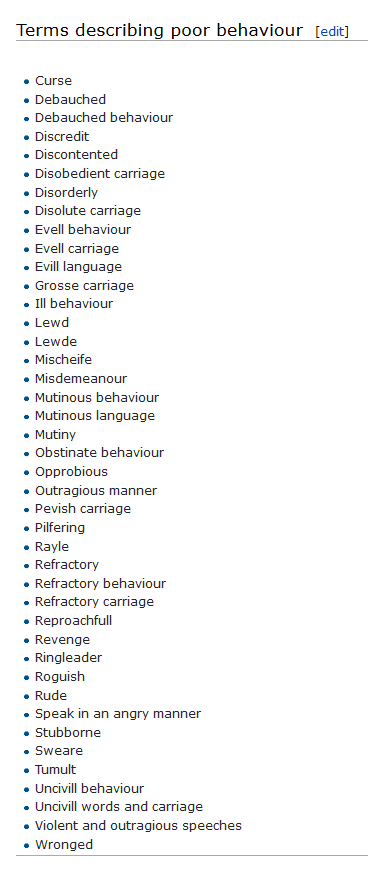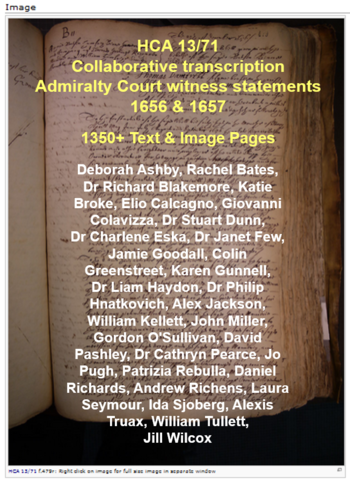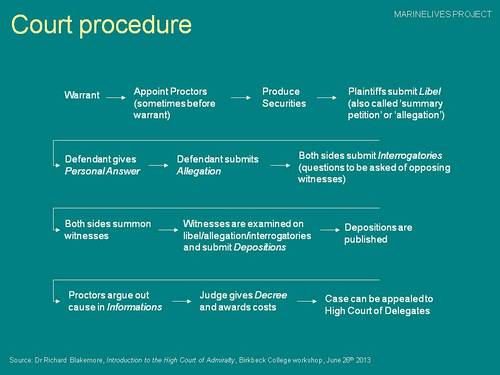MarineLives
Contents
- 1 Welcome to the MarineLives project
- 2 Letter from Daniel Sloyer in Cadiz to Albert Behrens in Hamburg, reporting death of Behren's brother-in-law, Vincente del Campo, January 23rd 1656
- 3 Georgius ab Ettenhart - Tesorero General de la Cruzado for Spanish monarchy (1643-1648)
- 4 Georgius ab Ettenhart, factor of Graf Fugger and Tesorero General de la Cruzado for Spanish monarchy, was a close relative of Zacharias Geizkofler (b.1560, d.1617), Reichspfenningmeister (treasurer) of the Holy Roman Empire
- 5 Juan Esćon - help us solve a mystery
- 6 The Silver Ships research project
- 7 Curses, debauchery, mutiny and revenge
- 8 Our readership
- 9 Our latest transcription challenge
- 10 Introducing our content
- 11 Our team based transcription programmes
- 12 The Court records
Welcome to the MarineLives project
The MarineLives collaborative public history project was established in 2012 to digitise, transcribe and annotate the manuscript records of the English High Court of Admiralty from the 1650s and 1660s. The original records are held at the National Archives in Kew.
The project is led and advised by academics and members of the general public.
In the last three years project volunteers have transcribed over 4.0 million words and 10,000 pages of Admiralty Court records and have uploaded 10,216 manuscript images of the records
To learn more or to volunteer please contact us
Letter from Daniel Sloyer in Cadiz to Albert Behrens in Hamburg, reporting death of Behren's brother-in-law, Vincente del Campo, January 23rd 1656
Please help us with our latest palaeographical challenge.
We have a letter from the Staatsarchiv Hamburg, written in German, by a Hamburg merchant living in Cadiz named Daniel Sloyer. He was writing to another Hamburg merchant, back in Hamburg, named Albert Behrens [alt. Berens]. The letter is dated January 26th 1656 and informs Behrens of the death in Cadiz of Vicente del Campo [alt. Vincent von Kampen], who was Albert Behrens' brother-in-law.
We have got the gist, which we publish here, but we are sure that you can improve on it.
Please Tweet your improvements to @Marinelivesorg or use our contact form to send us your suggested edits
Copia schreiben Daniel Sloyer, aus Cadiz den 23 January, Anno 1656. an H. Albert Berens in Hamburgh: Part A

[?XXX] [?Veter], [?XXXXXXXXX] [?Insonders] groβgünstiger [?herr], undt [?liebwerster] [?XXXüdt], demselben
[?meine] [?grund] [?XXXX], deβen angrur[?XXX] schreiben Von 24. November habe woll empfangen, eβ
mögen aller seiner fründs [?XX] des Elendt: und [?XXXXigen] todt des Sr. Vincent Von Campen
mitt [?fürgh] beklagen, Gott wolle [?seiner] [?Sohlen] gnädig] sein, will eβ der [?fedder] micht [?Vertrauen]
daVon [?relation?XX] [?thun] Von dem Waβ Vorgangen, undt passirt ist, umb an anders [?XXXX] [?XXX]
tragen, wir woll [?kpmanet] für seine [?XXXXXXX], wir [?XXX] aller seitt [?gethan], undt [?XXXXX]
[?mich] für ihm gesetzet in [?Colrus] gefahr, undt mitt [?zuin] aber meiner wollfahrt, undt
[?gerah?ten], Waβ ihm ge[?XXXXX], aber Er soll [?briven] [?zahtt] Von mir, [?XXX] andere [?gXXXXX] [?XXXX]
Wollen an[?XXXX], Undt [?Van] mist Viele dingen Von denselben, undt mir [?WXXXX] Vergeben
so W[?XXX] Er se[?varr] gü[?XXX], Her, undt reputation [?Were] [?üβiyh] Gott weiβ waβ
bessa[?Xxritt] [?weis] allers wirdt haben, Ich habe bey ihm gre[?X]an, daβ Gott, undt den [?XXX]
bru[?X]üst ist, [?SrXX] dispositiones auff [?XXXXry] Weiβ, seindt in seinem Erben al[?XXX
gantz [?XX] mist approbert; so [?]ire wirdt disparat seindt derselbe gru{?XXXX], maβen Er seine [?XX]
Copia schreiben Daniel Sloyer, aus Cadiz den 23 January, Anno 1656. an H. Albert Berens in Hamburgh: Part B

[?XXbrudrfraul], undt drey [?Vor]mundige Kindern, Sie Erben gemacht über seine güetter, Wan [?Er]
Aber dispa[?XXt] grut[?esen], ist ihm Sie Vergeben, [?Eβ] were besser daβ seine Correspondenten
[?rXX], waβ Er Verg[?rem], undt übell danken disponirt hatt, [?XXXurs] bedrukens [?XXβ] [?XX]
[?mieht] in seiner [?maeht] gru[?lesen] sein; wer aber Gott wegen das [?wreXXen] [?XXX] Vergeβen
dem kan eβ nicht woll gehen, den Gott läβet [?sih] nicht [?shertzen]: worin guetter herr[?XX]
undt frundt ich habe ein gre[?Xell], wan ich daran [?XXX] [?gedrucken], waβ passiert ist
Gott weiβ daβ ich [?muht] [?XXXXne] [??le] dingen [?Xxinig] [?XX] [?XXXin] [?XXXXXon] [?u] Vertr[?XX]
bitte aber Gott daβ ER seine Sohle gnädig sey, undt [?XXβ] nicht straf[?fe] in seinem [?XXX
dan Wir alle sünder sindt: [?nach] [abgelesnum] diesen brieff, bitte denselben [?zu] [?Verbrennen]
weil[?e] eβ meine Profession [?XXX] ist, [?librudigXX] [?mousten], [?Vire] [?weiniger] dem der todtist
[?XXXen] rerudigen sücces [?mag] [?sushriben], weill aber [?XXXX] [?vire] offenbahr ist, so word[?en]
Auff das herrn schreiben, undt ansui[?hen] dafur [?VXXanlaβet]. mundtlich [?wurde] [?dXX] [?herrn
Allesmitt [?XXXXrrn] [?XXXXXXX], aber wir oben g[?XXXget], Will eβ der [?XXXX] must Vertraulich
[?XXX] [?freundts grueβe [?XX] [?XXXX] [?XXXXXXX] [?XXXXXXXX] Daniel Sloyer [SIGNATURE]
Georgius ab Ettenhart - Tesorero General de la Cruzado for Spanish monarchy (1643-1648)
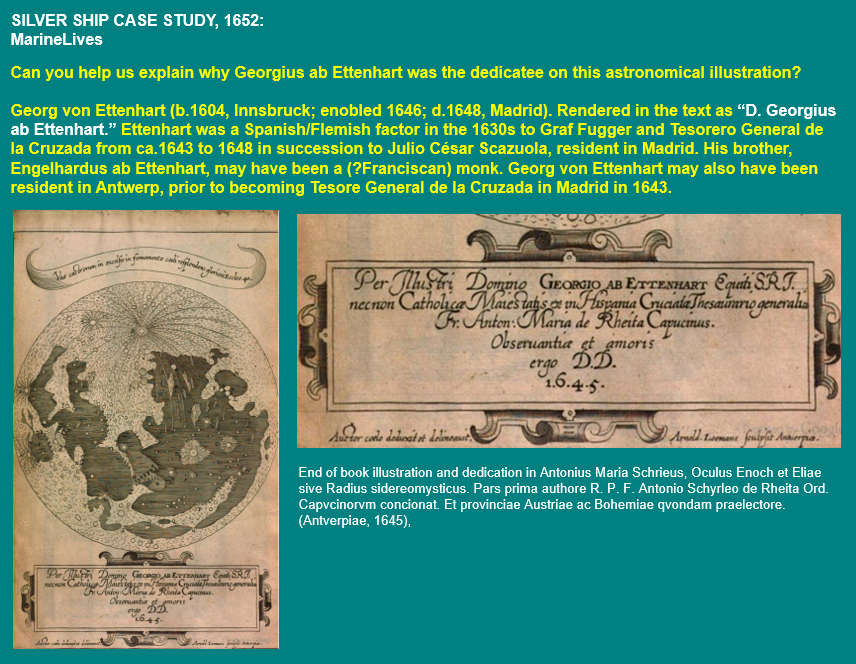
An astronomical book by Antonius Maria Schyrleus (1645) contains the following dedication: "Per Illustri Domino Georgio ab Ettenhart Equiti SRJ. necnon Catholicae Maiestatis ex in Hispania Cruciatae Thesaurario generalis Fr. Anton: Maria de Rheita Capucinus. Obseruantur et amoris ergo D.D. 1.6.4.5.".
Who was the dedicatee, and why was he so honoured? Please help us learn more about the man and his life.
What we know so far is that Georgius ab Ettenhart (b.1604, Innsbruck; d.1648, Madrid) was the Latin name of the Innsbruck born German Georg van Ettenhart, who was enobled by the Spanish monarch in 1646. In the 1630s, the same man, using the hispanicised version of his name ("Jorge van Ettenarden") was a leading Paguista on behalf of the Spanish Crown, funding military and other expenditure in the provinces of Flanders and Brabant. Ettenarden appears to have been acting together with Juan Paulo Lavaña, on behalf of the Fugger merchant-banking family.[1] Following the death of Julio César Scazuola in 1639, Ettenarden, also known as "Jorge de Hetenard", took over as Tesorería General de la Cruzada" (Treasury of the Crusado).[2]
As the deceased "George Etton Heard", he appears in the Silver Ships litigation in the English Admiralty Court (1652-1654), which is proving a rich historical source and case study linking Spain to the economies and networks of Antwerp, Amsterdam, Hamburg, and London.
You can read more about Georgius ab Ettenhart here, together with other Madrid based Assensistas, who had wool and silver on board the three Silver ships, which were seized by the English in November 1652.
Georgius ab Ettenhart, factor of Graf Fugger and Tesorero General de la Cruzado for Spanish monarchy, was a close relative of Zacharias Geizkofler (b.1560, d.1617), Reichspfenningmeister (treasurer) of the Holy Roman Empire

Zacharias Geizkofler von Gailenbach und Haunsheim (b.1560; d.1617) is the subject of a detailed entry in the online Deutsche Biographie by Ferdinand Blendinger (1964)[3] and a useful Wikipedia DE article.[4] Blendinger describes a talented youth, who studied law at the universities of Padua, Ingolstadt, Basel and Straßburg, following his schooling at the Gymnasium von Sankt Anna in Augsburg. He completed his legal education at Bourges and at the Reichskammergericht in Speyer. In 1584 he entered the service of the Fugger family, as had four of his father's brothers, but left the Fuggers in 1585, with their consent, to join the service of Erzherzog Ferdinand von Tirol. He came into close contact with the leading Habsburgs and his diplomatic skills were recognised by the Kaiser Rudolf II, who appointed him "Reichspfenningmeister des Heiligen Römischen Reichs" in 1589. The Geizkofler family archives in the Landesarchiv Baden-Württemberg contain correspondence with various members of the Fugger families from the 1680s through to Zacharias' death in 1617.[5]
The above-mentioned sources state that Zacharis Geizkofler was an imperial councillor at the Bohemian Court ("königlicher Rat am böhmischen Hof"), Reichsritter and Freiherr. From 1597 until 1603 he was Generalproviantmeister of the Imperial army in Hungary. As Reichspfenningmeister from 1589 it was his responsibility to collect the moneys for the Empire which had been approved by the Reichstag. His banking connections were put to use in terms of organising bridging finance. In his later years, having been forced out of the position of Reichspfenningmeister, he continued to advise successive emperors and chancellors on imperial finances. His son Ferdinand Geizkofler von Gailenbach und Haunsheim (b.1592; d.1653) was a contemporary of Georg von Ettenart.[6]
Zacharias Geizkofler is likely to have been related to Georg von Ettenhart, probably in multiple ways. We are still working on the exact relationship, but suspect he may have been a much older first cousin through Georg's father's sister. It is of course interesting that Georg van Ettenhart, who served as a factor for Graf Fugger in the 1630s, and then as Treasuer of the Office of Crusado for the Spanish King, was related to a man who performed an important financing function for the Holy Roman Emperor.
A web based genealogical source suggests that Zacharias Geizkofler's mother was "Barbara Ettenharterin" (sic) and that Barbara's parents were "Josef Ettenharter" and "Magdalena Flam".[7] If true, then Zacharias' mother was the sister of Engelhard ab Ettenhart, the father of Georg von Ettenhart [alt. ab Ettenhart], and Zacharias Geizkofler himself was a much older cousin of Georg von Ettenhart. Zacharias' birth in 1560 would make him forty-four years older than Georg, with his death in 1617 at the age of fifty-seven occuring when Georg was roughtly thirteen years of age.
The above would start to explain how the young George von Ettenhart became a factor for Graf Fugger in his early thirties, as is discussed by Karl Pohl (1972, 2005).[8] Zacharias Geizkofler was located in Augsburg and in his position as Reichspfenningmeister would have had excellent banking relationships with various German banking families, including the Fuggers. It is possible that documents in the Geizkofler family archive relating to Zacharias' son Ferdinand Geizkofler (b.1592, Augsburg; d.1653, Regensburg), a slightly older contemporary of Georg von Ettenhart, may contain references to Georg. These records are particularly rich for the period 1641-1646, when Ferdinand was württembergischer Statthalter and from 1644 württembergischer Hofkanzleidirektor.[9]
Juan Esćon - help us solve a mystery
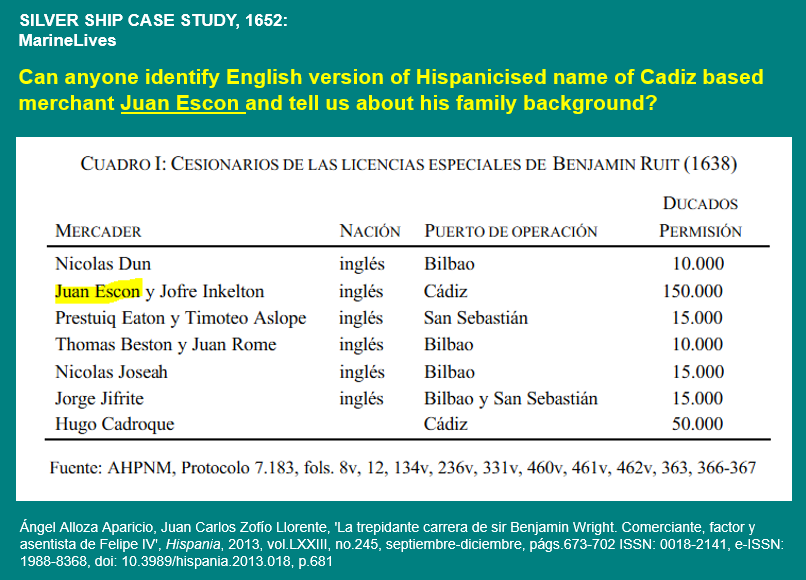
Juan Escon, also known as Juan Escout, was a Cadiz based merchant commercially active in the 1620s and 1630s, and possibly later. He was married to Margarita Enríquez, who was presumably Spanish. His daughter, Susanne Escon, married the Hamburg born merchant Vincent von Kampe, who was known in Spain as Vicento del Campo. Juan Escon and Vicente del Campo appear together in a commercial document dated 1640 for Cadiz related merchandize[10]
Juan Escon had several sons by his wife Margarita Enriquez, who were thus the (Anglo-Spanish) brothers-in-law of Hamburg born Vincent von Kampe: (1) Juan Escon Enriquez [11] (2) Pedro Escon y Enriques[12]
Vincent von Kampe played an important commercial role in litigation surrounding three Hamburg ships seized by the English in 1652 and suffered severe financial difficulties as a result of the seizures
Until recently we had believed Juan Escon to have been a native Spaniard. It now appears that he was an English merchant, who was English consul in Cadiz in the 1620s, and who was involved with the English merchant Sir Benjamin Wright in financing the Spanish Crown in the 1630s and 1640s. We are keen to identify his English name, and to understand his family origins and commercial activities. Can you help us?
Juan Escon may be the hispanicisation of an English name.
Ángel Alloza Aparicio, Juan Carlos Zofío Llorente (2013) name Juan Escon with a partner, Jofre Inkleton, and identify them as being of the "English" nation. The context is a list (as of 1638) of special licensees of Benjamin Ruit, who was the English merchant Sir Benjamin Wright, prepared from Spanish notarial protocols.

Adolfo de Castro (1857) provides background on the C17th Cadiz based "Escout" family, which appears to be synonymous with the family of Juan Escon and his successors, and which de Castro associates with the c. del Baluarte in Cadiz. He states in his entry for "BALUARTE (c. del) "A la mitad del siglo XVII se llamó de D. Juan Arnesto de Troya, regidor perpétuo que debió tener en esa calle las casas de su morada. En 1666 era concocida esta calle por de los Doblones, y en 1680 por de Juan de Escout. Este Juan de Escout obtuvo en 1637 cédula real para ejercer el cargo de cónsul de la natcion inglesa en Cádiz. Segun las actas del Ayuntamiento, en 1639 consiguió título de perpetuidad en su oficio por un donativo de cuatro mil reales hecho á S.M. En 1673 obtuvo un D. Juan del Campo y Escout título de regidor perpétuo de Cádiz. En mayo 26 de 1690 se concedió título de marquesa de Villa-Campo á doña Juana Escout y Enriquez. En instrumentos públicos aparece con el nombre de Baluarte de S. Felipe á mediados del siglo XVIII. D. Juan Escout y Margarita Enriquez habitaron en las casas del Torreon que debian hacer esquina á la plaza de este nombe. (Véase calle de la Aduana)...."[13]
The Silver Ships research project
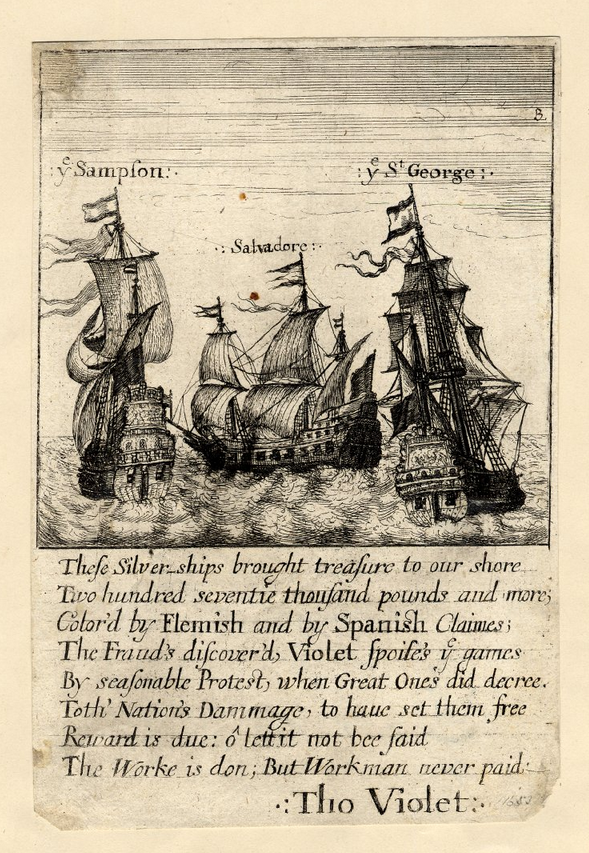
Three large ships (The Salvador, the Sampson and the Saint George), of supposed Lubeck and Hamburg build and ownership, were captured by the English in 1652 with highly valuable cargos of silver bullion.
The ships were on their way from Cadiz with bullion from the Spanish West Indies going northwards. It was disputed in the English Admiralty Court as to whether the ships were bound legally for the Spanish Netherlands, or illegally for Amsterdam.
The case was endowed with political as well as commercial weight - the Commonwealth, and then the Protectorate, was keen to have the bullion declared lawfull prize, but the Spanish government contested this.
The many and varied court depositions and other English Admiralty (and English and Spanish State Paper) records give very granular and highly colourful accounts of Seville and Cadiz, Hamburg and Lubeck, the Spanish Netherlands, the by-ways between the Spanish Netherlands and Amsterdam by which bullion could be smuggled overland and by canal, and the River Thames, where the ships and sailors were held following seizure.
Thomas Violet, a rather dodgy goldsmith, was involved as an agitator on behalf of the State, and published a pamphlet pleading for reimbursement of his efforts, which supplements the Admiralty Court material on the MarineLives wiki.
The Silver Ships project is being run by participants in the MarineLives 2015 summer transcription training programme.
Click to read more about the Silver ships and the historical and legal context of the resulting disputes.
Curses, debauchery, mutiny and revenge
Seventeenth century seamen of all nationalities were a boisterous lot, especially when "in drink". We have had some fun collecting some of the words used to describe poor behaviour, together with some of the rich language used amongst seamen.
We invite you to read about the Danish general's captain who told an English master of a ship that hs letters of marque were "good for nothing but to wipe his breeche with" (HCA 13/72 f.218v) and another English master who was alleged "in an outragious manner" to have reviled the merchants' factor calling him "old Roague and old Pedler and old Pimpe and the like disgracefull names" (HCA 13/73 f.3r)
For more examples click here.
Take a look too at a disciplinary code drawn up in 1647 by the master of the Mayflower, an English ship engaged in the slave trade.
Our readership
Our new MarineLives wiki went live on Wednesday May 27th 2015. The wiki has 21652 pages and 10134 manuscript images.
In the last thirty days we have had 857 users, 1224 sessions, 3949 page views and seven active contributors. A user in an average session looks at 3.2 pages in a session lasting three minutes forty-seven seconds.
Since launch of the MarineLives wiki we have had 6761 users, 8785 sessions and 25876 page views. A user in an average session has looked at 3.0 pages in a session lasting two minutes and fifty-four seconds.
Since we launched our beta of the MarineLives wiki on April 20th 2015 we have had 7393 users, 9537 sessions and 27713 page views. A user in an average session has looked at 2.9 pages in a session lasting two minutes forty-nine seconds.
Our latest transcription challenge
HCA 13/124 is a volume of Personal Answers submitted in the English High Court of Admiralty in the years 1650 to 1652. The original manuscripts are held at the National Archives, Kew, England.
A complete set of digital images is available on this wiki, together with transcriptions of the first eighty six folios.
We are currently looking for volunteer transcribers to work with us to finish the transcription of this volume. Volunteers will be supported by an experienced trained facilitator. Novice and experienced transcribers are equally welcome.
Please contact us to learn more about working as a volunteer to complete HCA 13/124.
Introducing our content
HCA 13/71 is a volume of witness statements or depositions submitted in the English High Court of Admiralty in the years 1656 and 1657. The original manuscripts are held at the National Archives, Kew, England.
This volume was transcribed between September 2012 and March 2013 by a team of volunteer transcribers working on the MarineLives project. Full text semi-diplomatic transcriptions of the full volume are published on this wiki with associated digital images from the original manuscript volume.
Click here to access the text and images
Click here for an alphabetical list of deponents
Click here for a geographical list of deponents
Our team based transcription programmes
We run regular team-based transcription programmes on-line, facilitated by trained team leaders, with teams of three or four volunteer associates. These programmes last twelve weeks, and will take a transcriber from a novice to a confident transcriber in that space of time.
Please contact us to discuss volunteering, or to explore how we might work with your University, School or Local History Society.
Thomas Davies was a third year history undergraduate student studying at Bath Spa University. In the summer of 2014, Thomas was a member of a four person virtual team of volunteers transcribing Admiralty Court witness statements from 1658 to 1660, facilitated by Dr. Philip Hnatkovich in Pennsylvania:
"There were some challenging aspects of the programme — the main being distance. This was because we worked as a team and half of the team were based in the United Kingdom and half were based in the United States, so we had to be aware of time differences and that we would be unable to meet in person.
To combat this we used email, Google Hangouts, and Skype and made good use of all the resources available to stay in touch when working on the documents together. We had weekly calls to discuss team business. The weekly calls helped because we would talk about the problems or issues we faced weekly and how the transcriptions were to be presented covering topics such as layout or abbreviations.
The biggest challenge I faced in the transcription itself was becoming accustomed to the peculiar writing and distinguishing letters. Some letters look very similar, such as f’s and s’s, r’s and c’s not to mention t’s and l’s. I began transcribing effectively by taking it slow and working out the letters individually instead of looking at the word as a whole as we do with modern writing. I found this approach to be very effective.
MarineLives created a Bath Spa student section that helped me significantly, showing templates of letters and the different forms they have. This allowed me to tackle the many different writing styles the clerks used. Once I was able to distinguish between letters more clearly with considerable practise, I found I could transcribe enough of the page to get a good idea of what was being said in the documents. Then, I could alter words that did not fit within the context of the deposition, or using the context as a guideline as to what certain words should be."
Katherine Parker is a Ph.D. candidate at the University of Pittsburgh. She is currently writing her dissertation entitled “Toward a more ‘perfect knowledge': British geographic knowledge and South Seas exploration in the eighteenth century. She participated in the MarineLives Ph.D. forum in 2013, and the MarineLives summer programme in 2014:
"On summer research trips to London in 2011 and 2012, I had looked at a few HCA documents and knew that the cases recorded in them offered rich material for social, economic, and naval history. Over the course of several skype meetings, I and other PhD students got to give our opinions about the proposed platform and methodology for transcription. Working with a team created a strong community aspect to the project from the beginning; I have always been impressed by the inclusiveness and openness that drives MarineLives. Also, it was refreshing to have my opinion valued as a PhD student, as sometimes that stage in one’s education is isolating and transitional—you are not yet qualified as an expert, but also not unknowledgeable about certain fields.
The value MarineLives placed on the voices of the PhD forum made me want to participate further, even though the works being transcribed were not strictly within the chronological bounds of my dissertation project. Thus, when the summer transcription project was created, I jumped at the opportunity to use paleographic and transcription skills I had gained after a year in London archives on a Social Sciences Doctoral Dissertation Fellowship (2013-14).
Writing styles change over time, just like clothing and furniture styles. Thus, the letters inscribed within HCA volumes from the mid-seventeenth century posed a challenge for me, as I am used to the fluid, upright cursive (often written by a trained scribe or clerk) of the mid-eighteenth-century Admiralty. I came to enjoy the challenge of squinting at the digital pages in front of me, willing the words to make sense, filling in paragraphs slowly until suddenly they all made sense."
The Court records
Click here for full listing of Admiralty Court records within scope of MarineLives project
The English High Court of Admiralty produced a wide range of documents.
The various steps in a particular case can be followed in summary form in the Acts of Court.
A case was commenced with the issuing of a Warrant by the Court, and the preparation of a Libell or an Allegation by the party commencing the case.
Prior to witnesses being called to make their depositions, the defendant or "respondent" might make a Personal Answer in response to the Libell or Allegation.
The most accessible of the court records are the statements made by witnesses, which are called Depositions. These depositions were in response to written Interrogatories, which were prepared by both plaintiffs and defendants in a case.
Various written documents were submitted by plaintiffs and defendants, as well as witnesses, during a court case. Some of these have survived as loose documents in the Instance Papers.
Many cases were settled prior to the giving of a formal verdict or Sentence. For those cases which went to sentence, the sentences can be found in document bundles. These bundles often include bills of expense related to the case, and in some cases include copies of the allegations or libells, and other miscellaneous documents.- ↑ Hans Pohl, Zur Bedeutung Antwerpens als Kreditplatz im beginnenden 17. Jahrhundert’ in Hans Pohl, Wirtschaft, Unternehmen, Kreditwesen, soziale Probleme, vol.1 (Stuttgart, 2005), pp.135-138
- ↑ Álvarez Nogal, Carlos, Los banqueros de Felipe IV y los metales preciosos americanos (1621-1665), Banco de España – Servicio de Estudios, Estudios de Historia Económica, no.36, 1997, p.117
- ↑ Onlinefassung, based on Blendinger, Friedrich, "Geizkofler von Reiffenegg, von und zu Gailenbach, Zacharias" in: Neue Deutsche Biographie 6 (1964), S. 167 f.
- ↑ Wikipedia DE article: 'Zacharias Geizkofler'
- ↑ Landesarchiv Baden-Württemberg: 9. Beziehungen der Geizkofler zu anderen auswärtigen Herrschaften und Adligen: 9.4 Beziehungen zu Grafen, anderen adligen Herren und städtischen Patriziern (A-Z): 9.4.3 Füeger von Hirschenberg - von Gemmingen
- ↑ Wikipedia DE article: 'Zacharias Geizkofler'
- ↑ Verein für Computergenealogie: 'Barbara Ettenharterin'
- ↑ Hans Pohl, 'Zur Bedeutung Antwerpens als Kreditplatz im beginnenden 17. Jahrhundert' in Hans Pohl, Wirtschaft, Unternehmen, Kreditwesen, soziale Probleme, vol.1 (Stuttgart, 2005), pp.135-138
- ↑ Landesarchiv Baden-Württemberg, Abt. 5. Staatsarchiv Ludwigsburg: 8. Beziehungen der Geizkofler zu Württemberg: 8.2 Unter Ferdinand Geizkofler (insbesondere während seiner württembergischen Statthalterschaft), 1641-1646; Wikipedia DE article: 'Ferdinand Geizkofler'
- ↑ Archivo General de Indias: ES-AGI-41091-UD-1859526 - ES-AGI-41091-UD-273566: Scope and content: Real Cédula aprobando la escritura de venta del 1 1/4% cobrado de las mercancías que entraren y salieren de Cádiz, hecha en nombre de S.M. por el presidente de la Contratación a favor del almirante Pedro de Ursua, Juan de Marte, Manuel de Iribarri, Baltasar Fernández Franco, Juan Bravo de Laguna, Juan Escon, Vicente del Campo, Benito Gómez etc, por el precio de 295.383 ducados y medio (fol.202). Acomp. Testimonio de dicha escritura de venta, condiciones y otros documentos sobre el asunto: Date: 30th May 1640
- ↑ Archivo General de Indias: ES-AGI-41091-UD-1859528 - ES-AGI-41091-UD-152527 Scope & content: Expediente de información y licencia de pasajero a indias de Juan Escón Enríquez, mercader, natural y vecino de Cádiz, hijo de Juan Escón y de Margarita Enríquez, a Tierra Firme, Date: 5th Feb. 1675
- ↑ Archivo General de Indias: ES-AGI-41091-UD-1859528 - ES-AGI-41091-UD-151522 Scope and content: Expediente de información de Pedro Escón y Enríquez, mercader, natural de Cádiz, hijo de Juan Escón y de Margarita Enríquez, a Tierra Firme. No hay licencia ni Real Cédula. Fecha final; Date: 23rd Sept. 1664
- ↑ Adolfo de Castro, Nombres antiguos de las calles y plazas de Cádiz: sus orígenes, sus cambios, sucesos notables ocurridos en ellas, idea de la antiguas costumbres locales (Cádiz, 1857), p.7

